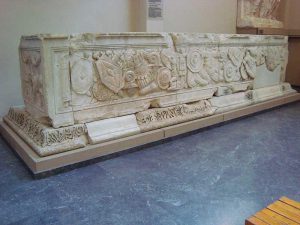Ephesus Museum in Selcuk Turkey
Ephesus Museum is 3 km from the ancient city of Ephesus. It is located in the town of Selcuk, where Ephesus is located.
It is one of the most important museums in Turkey with its cultural activities and visitor capacity, as well as important artifacts from the Mycenaean, Archaic, Classical, Hellenistic, Roman, Byzantine, Seljuk, and Ottoman periods in Ephesus and its surroundings. Since the Ephesus Museum is a museum that mainly exhibits the artifacts of an ancient city, it was preferred to exhibit the works according to the places they were found instead of a chronological and typological display.
Accordingly, the halls were arranged as Hillside Houses and House Artifacts Hall, Coin and Treasure Department, Grave Artifacts Hall, Ephesus Artemis Hall, and Emperor Cults Hall. In addition to these halls, various architectural and sculptural works are exhibited in harmony with the garden decoration in the inner and middle gardens of the museum.

Ephesus Museum is a rich and important museum for Ephesian and Anatolian archaeology with artifacts from digs at Ephesus, The Basilica of St. John, the Temple of Artemis, the Belevi Mausoleum, and the other local ruins. Including artifacts from the Mycenaean, Archaic, and Turkish periods as well, the majority are from the Hellenistic, Roman, and Byzantine periods.
The Ephesus Museum is not designed according to chronological order, in direct contradiction, each room has a composition pattern. For example, the rooms are called The House Findings Room, Terrace Houses Room, The Hall of The Fountain Relics, The Hall of The Funerary Relics, The Hall of Artemis, The Gladiators Section…
Highlights of the Ephesus Museum
Highlights of the Ephesus Museum include two colossal statues of the Artemis of Ephesus. Both statues have features like rows of bull testicles, thought to be breasts or eggs, but all symbolically related to the idea of fertility. There are two statues on display showing their former glory. These were found in the Prythaneion and dated back 1st century AD. One is known as Great Artemis and the other is Beautiful Artemis.

Among other works of art, inside the museum, there are household items, including the bronze statue of Eros with the Dolphin, dating back to the 2nd century, a fountain, and a faded 3rd-century fresco of Socrates. The fresco indicates the importance of philosophy in the daily life of the citizens. In this section the original statue of Bes is also exhibited in the museum, attached to an exaggerated erect penis. Bes protected everything associated with motherhood and childbearing among the Egyptian gods.
During the Roman Empire, Ephesus hosted an important school of medicine. In the museum, there is a collection of medical and cosmetic tools along with a wall of portraits of several famous Ephesian physicians, as well.
The statues of emperors, gods, and goddesses are displayed in the museum These statues belong to Pollio, Trajan, and Laecanus fountains at Ephesus. The statues of “Odysseus-Polyphemos” decorated the Pollio fountain. The other are statues of Aphrodite and Dionysius which decorated The Trajan Fountain.
The Foundation of Terrace Houses is in the first room of the Museum of Ephesus. In the first showcase are medical and cosmetic artifacts. The second case displays home religious cultic items. The most interesting thing is the ivory frieze which indicates the war between the Romans and Parthians.

The museum has a garden also that fits in with the local architecture. The sarcophagus from the 2nd century is decorated with beautiful ornamentations. Along the West Wall of the garden, there are graves and offering stones on display. The sundial in the center is in a half-moon shape.
Extraordinary exhibitions are held in the Ephesus Museum from time to time. The most important exhibition opened recently is the tombs of gladiators who lived in Ephesus, which were unearthed during the excavations of Ephesus. In addition to being the first mass gladiator cemetery found in the world during the excavations carried out under the leadership of Fabian Kanz and Karl Goldschmidt in 1995, the gladiators buried in the tomb have an extraordinary place due to their age, cause of death, and diet. While visiting Ephesus, we recommend that you stop by the Ephesus Museum and take a closer look at the history of Ephesus.

